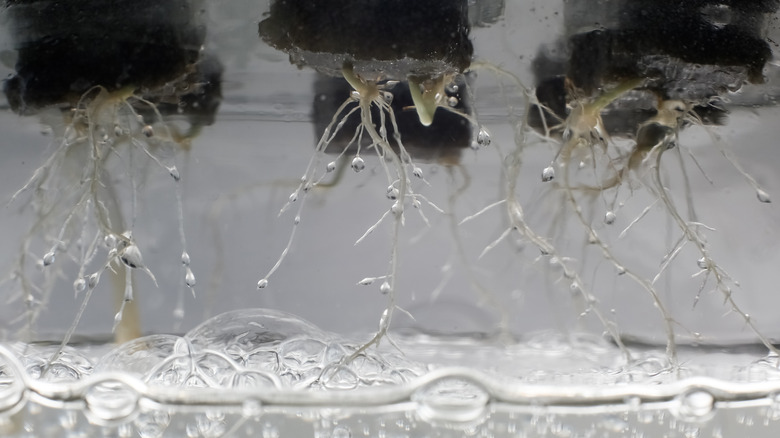Don't Try TikTok's Dollar Tree DIY For Hydroponic Gardening Without Knowing This
TikTok gardener @keep_on_growin wants you to try hydroponics, and he knows you can do it dirt cheap using some plastic containers from Dollar Tree (similar to these, 24 for $30 online), a pool noodle, and some vinyl sheeting. It's a great idea, but it has some problems. The main issue is that there's no opportunity for oxygen to get to the plant's roots ... one of the key challenges of hydroponics. Many of @keep_on_growin's other projects don't have this particular issue, so we'll walk you through a few approaches to improve this idea.
The basic idea of a hydroponic gardening system is to deliver water, oxygen, and nutrients to plants without the bother and expense of soil. It makes for a cleaner, ultimately cheaper, and easier system that ends up using less water than growing in soil. This can be accomplished in several ways, depending on the hydroponic method used. @keep_on_growin has devised a simple system that's similar to the Kratky method ... a sort of non-recirculating deep-water culture hydroponics, but with a few important differences we need to resolve.
How the TikTok hack works
The basic hack is extremely simple. @keep_on_growin — a creator named Mike VanDuzee — takes the Dollar Tree containers and covers them with the sort of stick-on craft vinyl sheeting (24 for $30 online) used for Cricut machines. He then cuts appropriately sized holes in the sides of the containers near the top; these will hold slightly compressed sections of pool noodles, as shown in this YouTube video made by VanDuzee. The pool noodle segment holds the stem of the plant with its roots in nutrient-rich water inside the container, a time-honored hack for hydroponic seed-starting and seedlings. With the caps screwed back on, these can be stacked, making for a somewhat precarious vertical garden at very little cost.
In the Kratky method, the plant roots are suspended some distance above the water, exposing them to air circulation, similar to the effect of an aeroponic rather than strictly hydroponic approach. The fresh air is replenished via gaps in the plant supports, depending on the design. Since the plants are usually secured in mesh net pots holding a medium like hydroton or Rockwool, fresh air usually has a chance to enter the space through these openings. This also provides an opportunity for the nutrient solution to absorb additional oxygen, which is crucial to the plants' success.
How it doesn't work ... and how to (mostly) fix it
Using a sealed container of water and nutrients without some way of getting dissolved oxygen into the water, or at least fresh air to the roots that aren't in the water, will stunt the plant. When roots don't get oxygen, plants don't do well. It will also produce anaerobic bacteria fed by the nutrients, which end up not only smelling like old flower water or even a septic tank, but also attracting diseases to the plant and likely preventing nutrients from being available. Your plants will be oxygen- and nutrient-starved while sitting in a pool of toxins.
This isn't ideal, but there's hope! One imperfect but workable solution is to leave the cap off and give the solution an occasional stir, as one might with compost tea. This partly arrests the anaerobic process by aerating the water and giving some roots direct access to oxygen. That should provide enough to support beneficial bacteria and simple plants like, say, leafy greens. A better approach would be to punch a couple of holes near the top of the container's sidewalls, then run a tube in from an aquarium air pump. In water that's not overly warm, this should introduce enough oxygen that one could even leave the top on for stacking. Of course, then you're going to trip on the air lines and topple the whole stack over, but we can't solve every problem in a day.

